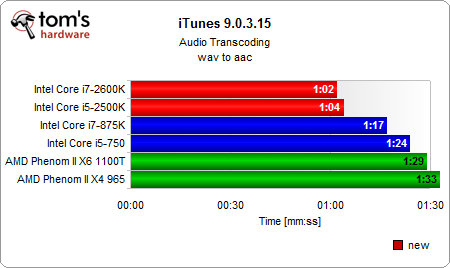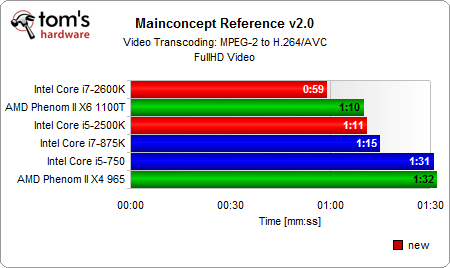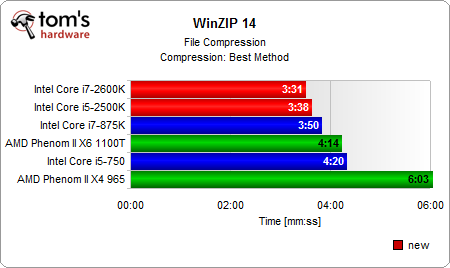Efficiency Comparison: Sandy Bridge Vs. Intel And AMD CPUs
The second-generation Core processors arrived with a bang, but what sort of progress can you expect in the performance per watt department? We compare Core i5/i7-2x00 to AMD's Phenom with four and six cores, as well as previous-gen parts from Intel.
Benchmark Results: Discrete Graphics Performance
These test runs are executed with a Sapphire Radeon HD 5850 plugged in instead of the integrated graphics solutions. We utilize the same motherboards, but exchange the processors on the LGA 1156-based platform, as the quad-core CPUs are much more relevant than the dual-core Core i3 and i5 with the built-in graphics. We keep the same AMD Phenom II X4 and X6 processors, as these are two of the fastest available options anyway.
One more time, we see excellent performance on the new Sand Bridge platforms.
With integrated graphics, the rendering times in 3ds Max 2010 are a bit different and AMD’s Phenom II X6 1100T is actually best. However, the new Core i7-2600K is almost as fast.
In HandBrake, the Core i5-2500K is a match for AMD’s six core top model, while the new Core i7 is up and away.
iTunes runs best on the Intel systems, no matter which one you're using.
Similar results can be found with Lame MP3 encoding.
The new Intel Core i7 flagship beats AMD’s Phenom II X6 top model in MainConcept.
Get Tom's Hardware's best news and in-depth reviews, straight to your inbox.
As mentioned before, Adobe Acrobat 9 requires a maximum performance per clock, but only utilizes a single core.
Results are more scattered in 7-Zip, which is thread-optimized. Therefore, the six-core Phenom does well, but can’t compete with the more advanced Sandy Bridge architecture anymore. Again, four cores beat six.
WinRAR is less thread-optimized, hence the highest clock speed wins unless there are only two cores.
Current page: Benchmark Results: Discrete Graphics Performance
Prev Page Benchmark Results: Integrated Graphics Performance Next Page Power Consumption Results








